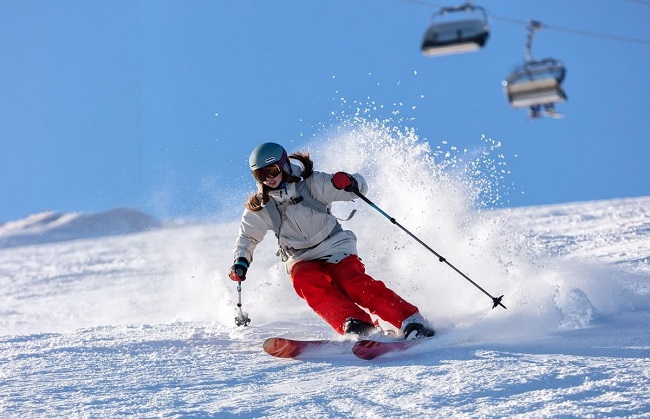Athletes’ reflexes and reflex quickness are put to the test in the Super Giant Slalom ski race. Slalom, giant slalom, downhill racing, and cross country skiing are just some of the many types of alpine skiing.
What does Super G Stand for
Alpine climbing, which can take place on both mountaineering routes and glaciers, is known as alpinism. Sprint races and endurance races are two categories that can be used to categorise racing events that take place on either real or fake snow surfaces.

Getting ready to compete at this level in one of these high-intensity sports might take years of practise and preparation.
The Abbreviation of “Super G” is what?
Skiers compete in the super giant slalom by racing down a very long and narrow course at speeds of up to 90 miles per hour. Racing down high mountains on skis is an extreme sport called alpine skiing.
Above the treeline in the mountains, alpinism comprises many distinct types of skiing, including downhill and cross country. As a high-stakes racing discipline, Super Giant Slalom necessitates not only exceptional reflexes and acceleration, but also exceptional strength, agility, and balance.
In alpinism, the focus is on raw athleticism and the mastery of complex technical terrain; it’s a sport that exemplifies true grit.
Slalom of Superhuman Proportions:
Skiing down a super gigantic slalom course needs a high degree of coordination, physical stamina, and quick thinking. Skiers and snowboarders reach speeds of up to 130 kilometres per hour as they race down an icy slope (80 miles per hour).
Featuring some of the world’s most breathtaking landscapes, this event has been a part of the Winter Olympics since 1936. In order to qualify for the super giant slalom competition, skiers must complete two qualifying races in length before moving on to the final round.
Beginning on February 9 and running through the 25th, PyeongChang, South Korea will host the 2017 Winter Olympic Games.
Timed Race:
Super G refers to the biggest gaming convention ever, and it will be held in Las Vegas from October 15-17 of this year. All gamers, whether they like PC, console, mobile gaming, eSports, etc., will be able to participate in the event’s many activities and tournaments.
More than 150 thousand people from all around the world attended last year’s Super G to vie for a total of $250,000 in cash and prizes.
The Play Station 4 (PS4) is making its debut this year as a console game with official support for events like tournaments and challenges.
Don’t miss out if you’re keen on participating or seeing out the action in person; tickets will be on sale very soon.
The Alpine Style of Skiing;
Super G is the name of a skiing discipline that involves racing down a hill at extreme speeds. The name refers to the incredibly quick group of skiers who can complete three laps in less than 45 seconds.
To compete, athletes employ a wide variety of snowboards and ski equipment, from downhill cycles to super-G skis with narrower frames.
The world’s most difficult slopes, like the Matterhorn in Andermatt, Switzerland, and La Plagne in Courchevel, France, play host to Super G competitions.
Some top athletes also engage in events like slalom and giant Slalom where they race against other teams through multiple courses at simultaneously
Assorted Races:
The racing cars are painted a bright green, hence the name “Super G,” which is an acronym for “super green.” Races can be followed on television or the internet from anywhere in the world.
The drivers battle it out at high speeds over curves and corners while onlookers cheer them on from the stands. Endings are frequently tense, leaving viewers wondering who will triumph the following time.
Don’t miss out on a race if you’re seeking for a heart-pounding experience.
Alpinism
The term “Super G” refers to the height at which a mountain was climbed. This acronym, which originally stood for “giant’s abominable hole,” was coined in 1924 by Andermatt guide Jakob Zacherer.
Those who achieve super g status are regarded as having achieved feats of climbing beyond what is normally possible for humans.
More than sixty-five mountains throughout the world have been designated as “super g” summits; these include Everest, K2, Kilimanjaro, Aconcagua, Elbrus, and Vinson Massif. Preparation is the cornerstone for climbers pursuing super g status on any climb, be it a little day walk or one of mountaineering’s most difficult routes.
In comparison to the GS, the Giant Slalom has a steeper vertical drop of more than 50%.
The Super G course is significantly longer than the normal downhill track, although both have their own unique rules and restrictions.
In Super G, skiers are ranked only on the basis of the combined times from their single run. Skiers need to be 16 years old to compete in the Giant Slalom, however kids as young as 12 can race in the GS (with parental permission).
Anyone can compete in either event, however to qualify for super-G they must collect points comparable to an A level ski race
A Super-G Ski Race is Defined as what?
Super-G is shorthand for the Olympic Gold Medal. This is the pinnacle of skiing, and only the best skiers in the world typically attempt it. There will be a qualifying phase, a main competition phase, and a final round in this race.
The Super G combines downhill skiing with the giant slalom.
The Super-G is a hybrid of the downhill and giant slalom disciplines. Athletes race down a slope at speeds of up to 120 mph, then compete on a course with jumps and curves similar to those found in a giant slalom. In 1991, Nagano, Japan hosted the first ever super-G competition.
Five events are currently held annually around the world. Three of these take place in Europe (Italy, Switzerland, and Austria), one in North America (Vail), and one in South America (Parana).